Why are kaffir lime leaves useful and how to use them in cooking and aromatherapy
Fresh and dried leaves of kaffir lime are prized for their tart, citrus-herbal aroma with woody notes and extraordinary health benefits. They are part of the famous Indian curry dish and the Thai soup Tom Yam. Aromatic tea is prepared from the leaves, which has a beneficial effect on psycho-emotional health, the digestive and genitourinary systems. Read about the benefits and dangers of kaffir lime, its use in cooking, read our article.
The content of the article
Kaffir lime leaves
Kaffir lime, Kaffir, Lima, Papeda black-headed lime, Kaffir lime, Porcupine citrus - all these are the names of one plant, Kaffir lime, originally from India. It is a medium-sized tree with thorny branches, small green bumpy fruits, reminiscent of the fruits of ordinary lime. The plant has white, fragrant flowers.
Especially valuable are the green leaves with a refreshing citrus scent and zero calories. They retain their freshness and smell for about six months in a sealed container. They are easily recognizable by their emerald green color and bivalve leaf blade, creating the illusion of double leaves fused together.
The leaf blade looks like an hourglass. The tip is pointed; it is attached to the bottom with an extended end. Length - 2-10 cm.
In the photo - the leaves of kaffir lime.
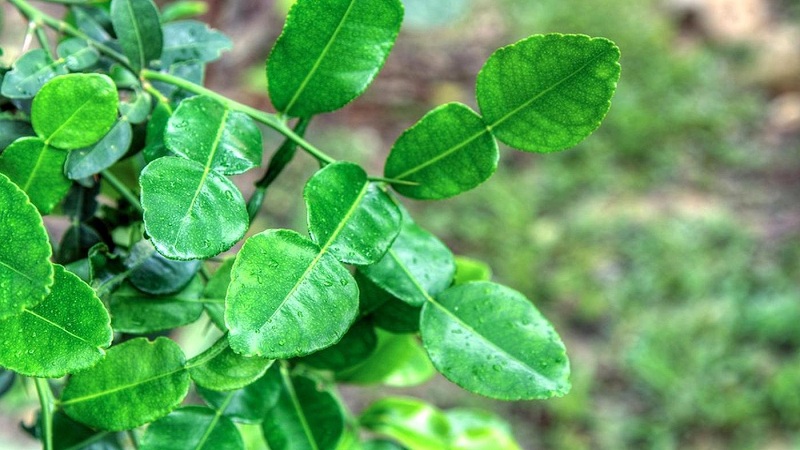
Taste and aroma
The range of citrus aromas is wide - the leaves smell simultaneously of lemon, tangerine, lime. The flavor combinations are similar. If you grind them, they will taste better.
Composition and useful properties
The leaves contain organic compounds, ascorbic acid, calcium, vitamin A, B2, essential oils and antioxidants.
These substances have a beneficial effect on the body:
- the aromatic compound limonene is responsible for a bright aroma and improves digestion, reduces the risk of bile throwing into the stomach;
- aldehyde citronel is responsible for the taste of the leaves and has antimicrobial effect;
- antioxidants bind and remove free radicals, reduce the negative effects of oxidative processes, prevent the development of cancers of the oral cavity, cervix and liver;
- kaffir lime leaves suppress the vital activity of streptococci, which create a biofilm on the surface of the teeth that destroys enamel and bone tissue;
- the extract relieves inflammation in arthritis and gout, removes excess fluid from the tissues;
- the product normalizes blood pressure, relieves spasms, tones and rejuvenates the body;
- in India and Thailand, greens are used to normalize sleep and calm the central nervous system;
- oil obtained by steam distillation is used in the treatment of acne, oily seborrhea, to even out complexion, lighten age spots, and reduce cellulite;
- leaf tea improves appetite, speeds up metabolism, cures colds, lowers fever, restores sexual function, lowers sugar levels;
- kaffir lime prevents premature graying, cleans hair from chemicals contained in cosmetics, and gets rid of dandruff.
Cooking applications
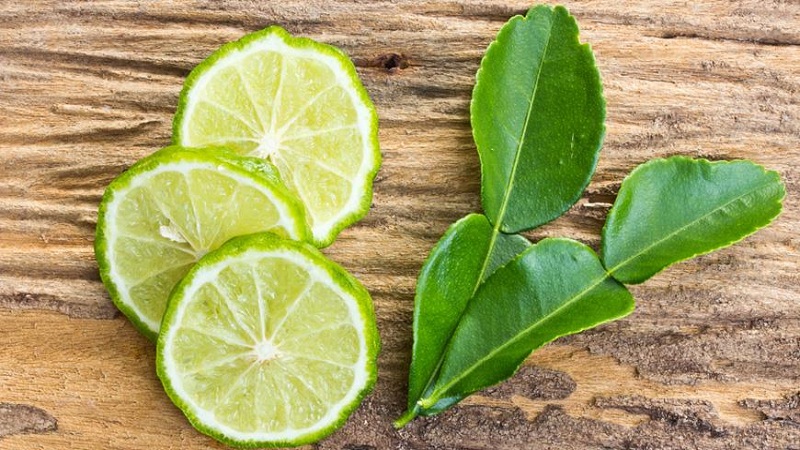
Kaffir lime leaves are common in Pan-Asian and Indian cuisines. They are put in soups, salads, curries, cereal side dishes.
How is it processed
The leaves have a dense structure, so before they are put into a dish, they are prepared:
- Wash and remove coarse bitter streaks.
- Fold 3-4 leaves of the same size or twist into a tube and chop with a sharp knife.
What dishes are added
For the preparation of soups and sauces, whole greens are used and caught from the finished dish. So, for example, they do with lavrushka.
Fragrant leaves:
- put dry or fresh in Tom Yam and Indian curries, soups with coconut milk, creamy sauces;
- include garni with ginger and lemongrass in the bouquet;
- added to water when cooking rice;
- combined with galangal root, chili pepper, shallots, basil, cardamom, caraway seeds, mint, turmeric, tamarind;
- added to fish and seafood dishes;
- put in pickles for cucumbers, eggplant, zucchini, lamb and pork.
What can be replaced
It will not be possible to completely replace the product in dishes, but you can reproduce a similar aromatic composition using the combination:
- Lime zest, lemon thyme and bay leaf. The zest has a pungent, citrus aroma, lemon thyme gives a light citrus-herbal note, laurel gives a herbal scent with light floral notes. For ½ bay leaves take ¼ tsp. zest and thyme. The mixture is added to first courses, sauces, curries, fish and vegetables.
- Lime leaves, lemon or grapefruit with bay leaf and lemon thyme. This mixture is suitable for soups, potatoes and meats.
Tea recipe
Kaffir lime leaves are used to make tea with a mild citrus aroma and a light spicy ginger aftertaste. They are paired with fruits, herbs, lemongrass and ginger.
Tea recipe for a 1.5 l French press: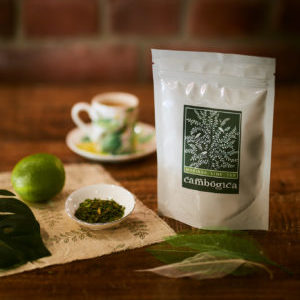
- lemongrass - 2 stems;
- lime leaves - 3 pcs.;
- fresh ginger root - 2 cm;
- boiling water - 1.5 liters.
Preparation:
- Lemongrass stems are beaten and cut into pieces.
- Lime leaves are washed and cut into strips.
- The skin is cut from the ginger root and cut into circles.
- The ingredients are placed in a teapot, poured with boiling water and infused for 10-15 minutes.
Where to buy and how much does it cost
Kaffir lime leaves are hard to find commercially. They are common in Southeast Asia... In Thai or Vietnamese markets, they are sold fresh, dried or frozen.
The product can be ordered from online stores specializing in the supply of food from Thailand, or purchased from supermarkets. Packages with leaves are found in the vegetable, herbal and herbal sections or in the spice and exotic food section. The price for 100 g of leaves ranges from 170 to 250 rubles. depending on the supplier.
How to choose the right one
Fresh leaves have an emerald color, the leaf blade is dense, not sluggish, without dark spots and damage, the aroma is pronounced.
The dried product has a less pronounced aroma, the color is green, muted.
When buying, pay attention to the date of packing. The fresher the product, the brighter the aroma.
Terms and conditions of storage
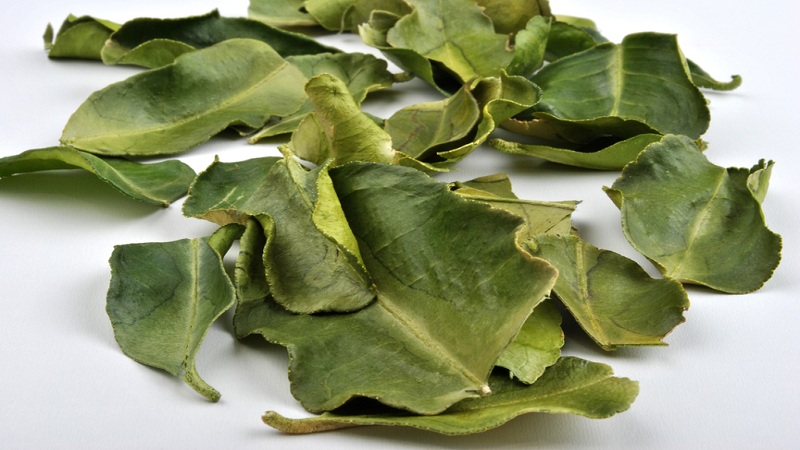
The shelf life of dried kaffir lime leaves is 18 months. The product is kept in a cool, dark place at a temperature of maximum + 25 ° C, air humidity not exceeding 85% in a glass jar or craft bag.
Fresh leaves are frozen and stored in the freezer for about a year. Low temperature does not change their chemical composition, does not reduce useful properties, taste and aroma.
Green leaves are kept in the refrigerator in the vegetable and greens compartment for up to two weeks.
Drying of leaves and application features
Lime leaves are sun dried to preserve flavor and aroma. They are used not only for culinary purposes, but also added to a hot bath, hung on verandas to flavor rooms.
Dry leaves are placed in linen bags or in shoes, between bed linen. This removes unpleasant odors.
Aromatherapy Applications
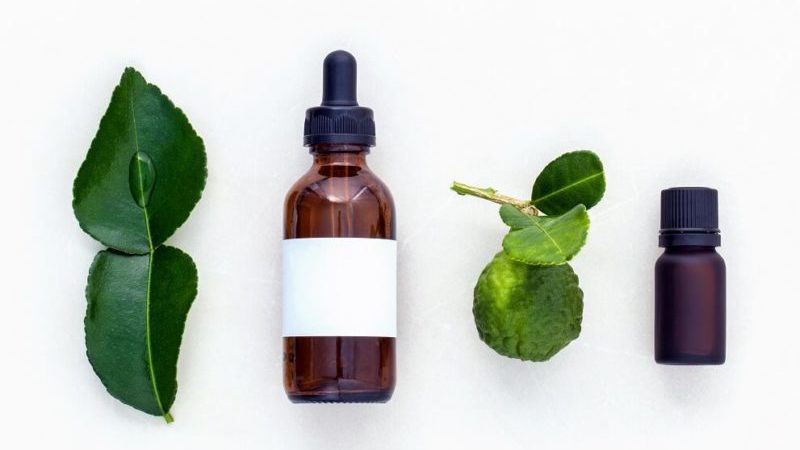
Kaffir lime oil is used in aromatherapy - in aroma lamps, vaporizers. Pure essential oil is mixed with water 1: 100.
Delicate citrus aroma relieves stress, anxiety, and has a slight sedative effect.
Reference. Kaffir lime leaf oil is considered a powerful aphrodisiac.
Contraindications and possible harm
Kaffir lime leaves are safe for human health and rarely cause side effects. In some cases, when plant juice gets on the skin, photodermatitis occurs under the influence of the scorching rays of the sun.
The product is contraindicated:
- if you are allergic to citrus fruits, it can cause Quincke's edema, hives and itchy skin;
- in the first trimester of pregnancy;
- children under 12 years old.
It is interesting:
What is an orange tree and how does it bloom.
Conclusion
The aromatic leaves of kaffr lime are used in cooking to give dishes a delicate citrus aroma. They are put in soups, stews, sauces, cereals, garni bouquets, combined with meat, fish and seafood.
In Thai and Indian traditional medicine and aromatherapy, they are used to normalize blood pressure, digestion, and psycho-emotional state. Tea made from the leaves improves mood, relieves anxiety, helps to overcome insomnia, cure colds and reduce body temperature.